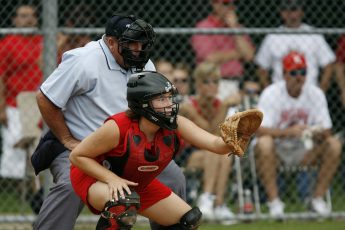Introduction
Quick Navigation
Softball is a modified form of baseball. Softball is played on a smaller pitch with a big ball when compared to baseball. A game of softball consists of two teams of ten players and two extra hitters each. There are nine different positions in a softball team. They are catcher, first base, pitcher, second base, shortstop, third base, center field, left field, and right field. To play softball, a ball, a bat, and gloves are the necessary gear. Due to the large size of a softball, softball gloves are large than baseball gloves, and they have deeper pockets. A softball glove has parts that include pocket, fingers, heel, and palm. Synthetic or leather are the raw materials making softball gloves. Regardless of being cheap, most players go for the leather made gloves because the synthetic gloves have a shorter lifespan, degrades over time, and performs poorly
Types of gloves in softball
There are different types of gloves used in softball, and it depends on the position played. These gloves include;
- Catchers gloves
- First basemen mitt
- Infield glove
- Outfield glove
These gloves differ by the depth of their pockets. Infield gloves have shallow pockets that make ball retrieval quicker. The outfield glove has deeper pockets that help secure fly balls with greater consistency. First base gloves are longer than other gloves, and their fingers are not separated but are in a web. The web allows for easy scooping of poorly thrown balls and rolling balls. Similar to first base gloves, catcher’s mitts are also closed web. However, they are well padded and are useful in catching high velocity throws. There are also custom made gloves. When making these gloves, they follow specifications, and you cannot get them from the shelf. You can order softball gloves from top brands at great prices. You can check Top Softball Glove Brands here and also Custom Softball Gloves here.
Catcher Gloves
Catcher’s gloves are also known as mitts because the fingers are webbed together. They also have extra padding and have a claw-like shape. The shape provides a good target for pitchers and also helps catch fastballs. Some factors should be put into consideration when choosing a glove. These factors include webbing, back, padding, material, and sizing.
The webbing should be open. Although this glove design sacrifices some support by putting the fingers together, the glove provides the necessary visibility to catch the ball. The glove also comes in larger sizes. The back of the glove should be open. An open glove back increases mobility. This mobility is because there is space between the wrist strap and the upper part of the glove. Padding protects the hand. However, too much padding will not leave room for a big ball. When purchasing this type of glove, note the specifications, and it should specifically be for softball.
Another criterion to consider is the break-in time. Gloves become stiff because of a large amount of padding in a glove, and it may take a long time to break them to a point where they are game ready. Therefore, it is crucial to consider the time necessary to break the gloves thoroughly. Materials used in making catchers gloves include leather, synthetic, and pigskin. Time and length of usage will determine the type of material when choosing a glove.
Synthetic or pigskin gloves may not last beyond one season, but the materials are cheaper. Gloves made with synthetic materials are usually a good option for younger players. Players who are not playing for multiple seasons also use this type of gloves. Gloves made from leather are expensive, but they do not wear out quickly. The gloves can last for years, and this makes the price worth it in the long run. Leather gloves can last for a long time if treated with substances to soften the leather and prevent it from drying. Check out How to soften leather softball gloves to know more about caring for your leather gloves.
Another criterion to be considered in choosing gloves is sizing. For a softball catcher, the circumference is the measure for the glove. Circumference also depends on age. The larger the glove circumference, the larger the glove and the larger the pocket for the ball. As much as big gloves are necessary for softball, there should be a balance. The balance increases visibility and agility.
Catcher Glove Sizes
It is crucial to choose gloves that fit perfectly and are also the right size. The standard size range for a softball catcher mitt is 29.5 to 35 inches. Size measurement is about the circumference and not the length of the glove.
For a softball fielder, measure the glove along the length. For a softball catcher, follow these steps to measure the glove.
- The first step is to spread the glove as wide as possible.
- Afterwards, press the mitt downward with the palm side facing down on a flat surface to flatten it out as much as possible.
- The last step in the measurement is to use a measuring tape around the glove. The number is the circumference or size of the glove.
The size of the glove differs for players depending on their age group. They are as follows;
- Players below the age of 7 will use between 29.5 to 30 inches gloves.
- Players between ages 8 and 10 use gloves between 30 to 32 inches.
- Players aged between 11 and 13 use gloves between 31 and 32.5 inches.
- Players from 14 years and above use gloves between sizes 33 to 35 inches.
To find out about measuring glove sizes for different softball positions, check out this article. How to determine softball glove size
Conclusion
There are different positions in softball, and the catcher position is an example. Gloves are part of a softball player gear, and a softball catcher glove is different from other softball positions glove. A good fit is necessary when purchasing gloves, and this depends on glove sizes. Glove sizes vary for age groups, and it is crucial to choose a fitting glove during purchase. If you do not want to purchase gloves from the shelf, you can order custom-made gloves from top brands.

